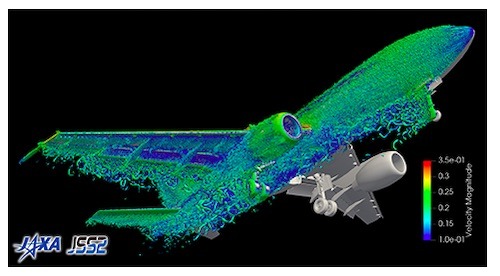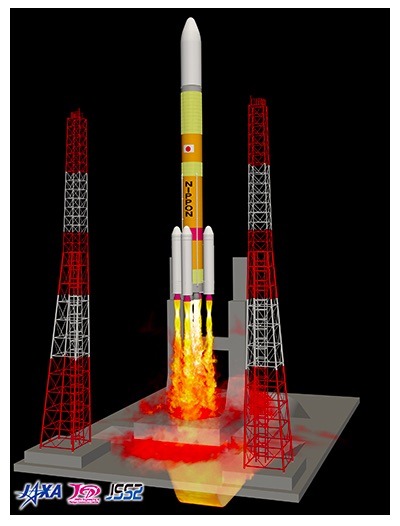- Fujitsu’s new computing system for the Japan Aerospace Exploration Agency’s will consist of Fujitsu Supercomputer PRIMEHPC FX1000 with 19.4 petaflops (approximately 5.5 times the theoretical computing performance of the current computing system), in addition to 465 nodes of x86 servers Fujitsu Server PRIMERGY series for general-purpose systems handling diverse computing needs.
- Equipped with highly versatile Arm architecture CPU A64FX, PRIMEHPC FX1000 enables application of various software, leading to widespread use of JAXA’s research results.
- New system will be used for conventional numerical simulations, AI computational processing platform for joint research/shared use, and large-scale data analysis platform to aggregate/analyze satellite observation data.
TOKYO, Apr 22, 2020 – (JCN Newswire) – Fujitsu today announced that it has received an order for a supercomputer system from the Japan Aerospace Exploration Agency (JAXA), as the organization plans to expand its use in the HPC field in addition to conventional numerical simulations. Scheduled to start operation in October 2020, the new computing system for large-scale numerical simulation, composed of Fujitsu Supercomputer PRIMEHPC FX1000(1), is expected to have a theoretical computational performance of 19.4 petaflops(2), which is approximately 5.5 times that of the current system. At the same time, Fujitsu will implement 465 nodes of x86 servers Fujitsu Server PRIMERGY series for general-purpose systems that can handle diverse computing needs.


The system will contribute in improving the international competitiveness of aerospace research, as it will be widely used as the basis for JAXA’s high-performance computing (HPC). It is also expected to be used for various applications, including a large-scale data analysis platform for satellite observation and an AI calculation processing platform for joint research.
Developmental Background
As it conducts research of space development, aviation technology, and related basic technology, JAXA has used supercomputer systems to develop numerical simulation technologies such as fluid dynamics and structural dynamics in the study of aircraft and rockets. In recent years, in addition to conventional numerical simulations, the system has been expanding their role in the HPC field. For example, the system has processed earth observation data collected by satellites for use by researchers and the general public, while it has been used in AI calculations, including deep learning. JAXA is currently operating a supercomputer system JSS2(3) comprised of SORA-MA(4), which consists 3,240 nodes of Fujitsu Supercomputer PRIMEHPC FX100, and J-SPACE(5) that stores and manages various data using a large-capacity storage medium.
Features of the New Supercomputer System
As a successor to the JSS2 system, Fujitsu will implement a computing system for large-scale numerical simulations. The system will consist 5,760 nodes of PRIMEHPC FX1000, which utilizes the technology of supercomputer Fugaku jointly developed by Fujitsu and RIKEN. It is expected to have 19.4 petaflops, approximately 5.5 times the theoretical computing performance of the current system, in double precision (64 bit) usually used in simulations. In addition, a total of 465 nodes from x86 servers Fujitsu Server PRIMERGY series equipped with high memory capacity and GPU(6) will be deployed as they compose a general-purpose system capable of handling a variety of computing needs. With a large file system capacity of approximately 50 petabytes, including high-speed access storage system of approximately 10 petabytes, the new system will offer high performance and ease of use. The implementation of PRIMEHPC FX1000 equipped with a highly versatile Arm architecture CPU A64FX will enable the application of various software and contribute to the widespread use of JAXA’s research results.
Future Plans
While enhancing the global advantage of JAXA’s aerospace research in the conventional numerical simulation field, the system, as the foundation of the Agency’s HPC infrastructure, will be used for an AI computational processing platform for joint research and shared use. The system will also be applied to a large-scale data analysis platform for aggregating and analyzing satellite observation data that had been previously stored and managed by different divisions at JAXA.
Fujitsu will support JAXA in making its philosophy a reality by solving its issues with experience gained through supplying supercomputer systems to the Agency since the 1970s. Offering PRIMEHPC FX1000 worldwide, the company will contribute in solving social issues, accelerating leading-edge research, and bolstering the competitive edge of corporations.
Comment by Naoyuki Fujita, Manager for Supercomputer Division Security and Information Systems Department, JAXA
A large-scale numerical simulation environment has been essential in JAXA’s long-ranging research and development in the aerospace field, and the currently operating JSS2 has greatly contributed to such progress. We expect that the new system will further improve simulation performance with PRIMEHPC FX1000, which utilizes Fugaku technology that excels in large-scale research. Moreover, we hope that it will play an active role in research in new fields such as AI.
(1) Fujitsu Supercomputer PRIMEHPC FX1000 Features the CPU A64FX adopting Scalable Vector Extension (SVE) which is an extension of the Arm v8-A architecture for supercomputers. It achieves high performance per power and scalability.
(2) Petaflops Short for Peta Floating-point Operations Per Second. It is a unit of computing power that indicates the number of floating-point operations per second. Peta stands for 1,000,000,000,000,000 (15 raised to the power of 10).
(3) JSS2 Short for JAXA Supercomputer System Generation 2. This second-generation supercomputer system at JAXA has been in operation since April 2016.
(4) SORA-MA Short for Supercomputer for earth Observation, Rockets, and Aeronautics (Main). It is the main system in JSS2 and has a theoretical computational performance of 3.49 petaflops. Highly tuned program assets can be executed in highly parallel environments and on a large scale.
(5) J-SPACE Short for Jaxa’s Storage Platform for Archiving, Computing, and Exploring. Various data can be archived, as High Performance Storage System (HPSS) manages 3 petabytes disk and 60 petabytes tape media in tiers.
(6) GPU Short for Graphic Processing Unit, which applies hardware used for image processing to both image processing and numerical calculation. With high computing performance, GPU is increasingly being used in supercomputers.
(7) Image simulated with the current system “JSS2” (flight environment) As part of the “Social and scientific priority issues to be tackled by using the Supercomputer Fugaku” promoted by the Ministry of Education, Culture, Sports, Science and Technology (MEXT), this initiative represents the Sub-issue D “Research and development of core technologies to innovate aircraft design and operation” under the Priority Issue 8 “Development of innovative design and production processes that lead the way for the manufacturing industry in the near future.”
(8) Node configuration XL node, L node: Node for non-parallelized specialized application. There are two types, XL and L, depending on the capacity of the main memory. M node: Node that perform computational processing for such specialties of GPUs as AI and Deep Learning. S node: Node that runs an application in high parallel. This is for general applications such as commercial applications.
For more information, please visit www.fujitsu.com.












